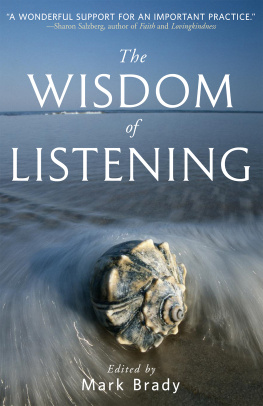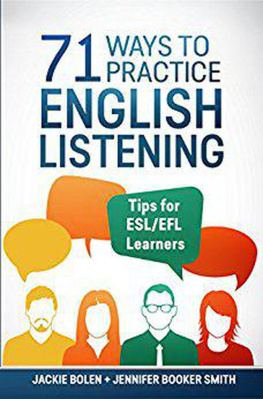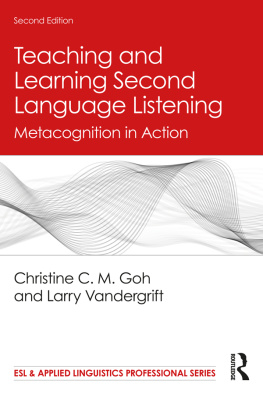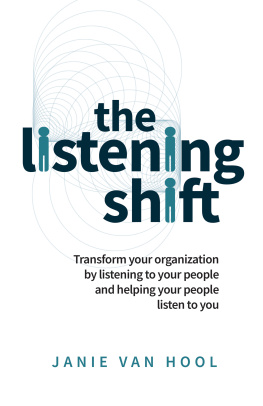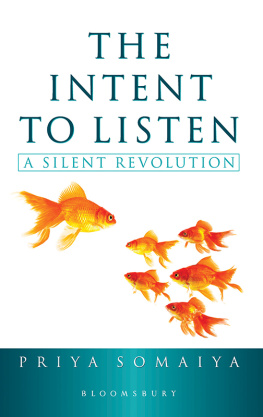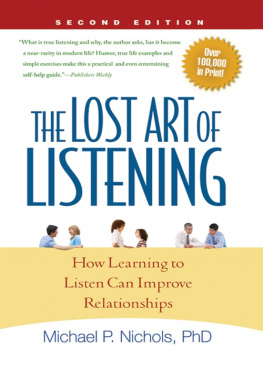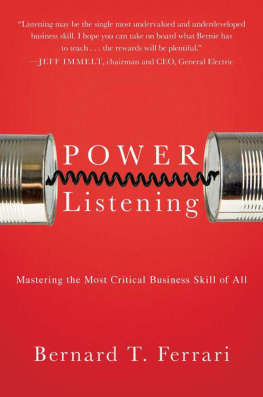Table of Contents
List of Illustrations
- Chapter 1
- Chapter 2
- Chapter 3
- Chapter 5
- Chapter 6
- Chapter 7
Guide
Pages
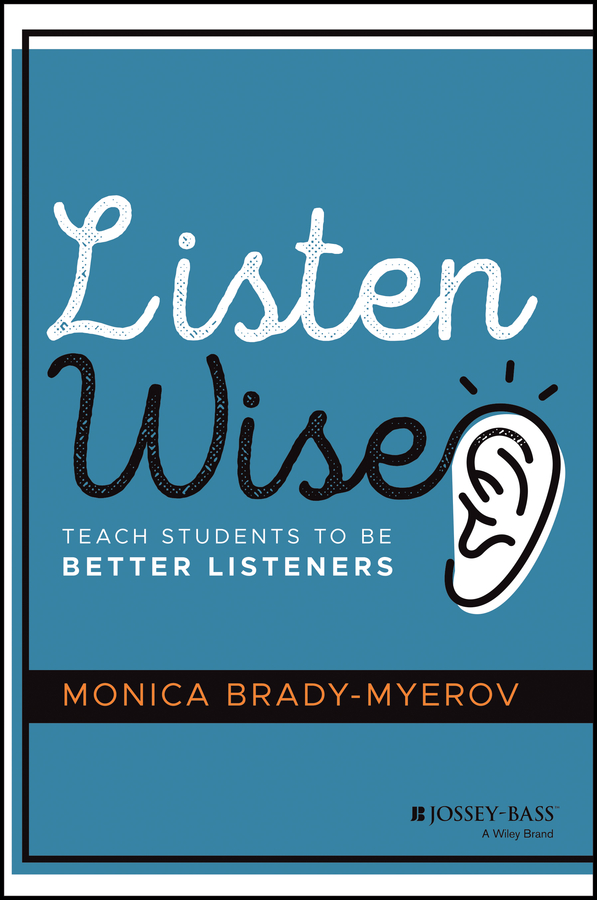
LISTEN WISE
Teach Students to Be Better Listeners
Monica Brady-Myerov

Copyright 2021 by John Wiley & Sons, Inc. All rights reserved.
Jossey-Bass
A Wiley Imprint
111 River St, Hoboken, NJ 07030
www.josseybass.com
No part of this publication may be reproduced, stored in a retrieval system, or transmitted in any form or by any means, electronic, mechanical, photocopying, recording, scanning, or otherwise, except as permitted under Section 107 or 108 of the 1976 United States Copyright Act, without either the prior written permission of the Publisher, or authorization through payment of the appropriate per-copy fee to the Copyright Clearance Center, Inc., 222 Rosewood Drive, Danvers, MA 01923, phone +1 978 750 8400, fax +1 978 750 4470, or on the web at www.copyright.com. Requests to the Publisher for permission should be addressed to the Permissions Department, John Wiley & Sons, Inc., 111 River Street, Hoboken, NJ 07030, phone + 1 201 748 6011, fax +1 201 748 6008, or online at www.wiley.com/go/permissions.
Limit of Liability/Disclaimer of Warranty: Although the publisher and author have used their best efforts in preparing this book, they make no representations or warranties with respect to the accuracy or completeness of the contents of this book and specifically disclaim any implied warranties of merchantability or fitness for a particular purpose. No warranty may be created or extended by sales representatives or written sales materials. The advice and strategies contained herein may not be suitable for your situation. You should consult with a professional where appropriate. Neither the publisher nor author shall be liable for any loss of profit or any other commercial damages, including but not limited to special, incidental, consequential, or other damages.
Jossey-Bass books and products are available through most bookstores. To contact Jossey-Bass directly, call our Customer Care Department within the U.S. at 800-956-7739, outside the U.S. at +1 317 572 3986, or fax +1 317 572 4002.
Wiley also publishes its books in a variety of electronic formats and by print-on-demand. Some material included with standard print versions of this book may not be included in e-books or in print-on-demand. If this book refers to media such as a CD or DVD that is not included in the version you purchased, you may download this material at http://booksupport.wiley.com. For more information about Wiley products, visit www.wiley.com.
Library of Congress Cataloging-in-Publication Data is Available:
ISBN 9781119755494 (hardback)
ISBN 9781119755531 (ePDF)
ISBN 9781119755524 (ePUB)
Cover design: Wiley
Cover image: Brandon Laufenberg/Getty Images
FIRST EDITION
Acknowledgments
I would never have started Listenwise and thus had the experience to write this book if my husband Adam Brady-Myerov hadn't listened to me when I said I had an idea. He didn't poke holes in it or ask whether I was qualified to be an edtech entrepreneur, he just listened and said Go for it. I want to thank him for always listening. And to my children, who have taught me so much, thank you for your love, support, and patience.
I want to thank many people for helping me with this book. Thank you to my sister Liz Witherspoon for editing as I wrote and being so supportive. Thanks to Aja Frost, a former intern and friend, for helping me first get the ideas on paper. I want to thank Alistair Van Moere, the Director of Product for MetaMetrics, for co-writing the chapter on assessing listening. Also thanks to Heather Koons of MetaMetrics for her contributions to the listening and reading chapter. Christin Wheeler, a reading specialist, shared valuable insights with me. Rachel Kramer Theodorou, a professor at Brandeis University, contributed her expertise with English learners. My team at Listenwise has been a huge help and inspiration. I could never have done this without Karen Gage, my business partner and friend. Dr. Marielle Palombo, Director of Curriculum, provided valuable insights and many, many edits to the book. Without team members Adam Buchbinder, Chelsea Murphy, Erica Petersen, Matt Pini, and Vicki Krupp I never would have learned so much about listening as we grew the company together. Thank you to the many teachers who have provided their insights and stories for this book, especially Jim Bentley and Scott Petri.
Thank you to my mother for telling me I could do anything I wanted and pushing me to do it. And to my father for asking me to read him the New York Times while he drove. Reading out loud to my father launched me on this path and I dedicate this book to his memory.
Introduction
My students don't listen!
That's what almost every teacher says when I tell them that, after a career as an NPR reporter, I have started an education company focused on listening. They tell me they must repeat themselves when explaining how the Civil War got started. Or demonstrate a math concept over and over. They give simple homework directions in multiple ways. They call out to students many times before they have their attention. They lament that their students are poor listeners.
Might every student struggle with this most basic skill? Listening. If you were to stop a hundred teachers at an education conference and ask them this question, as I have, you will find that yes, listening is something that teachers report most students don't know how to do well. And teachers are at a loss for what to do about it. This book will help.
Listening is a skill that can be modeled, taught, and improved. I have learned this on my journey from an award-winning public radio reporter to the founder of an education technology start-up called Listenwise, a website for K12 teachers that uses the power of audio stories to advance listening and literacy skills in all students.
HOW THIS BOOK IS ORGANIZED
I organized this book to build the case for teaching listening, but also as a practical guide for K12 teachers interested in using audio in their teaching, with class activities sprinkled throughout the book. The strategies and activities include suggestions for elementary students and middle/high school students. Readers should start from the beginning and work through to the end for the most comprehensive understanding of how and why to teach listening comprehension. However, you can also jump to the chapter on English learners or listening and reading, if that's where your interest lies. I structured the book to start with and build on academic research and my personal experience in the field as a reporter, because I've learned many people need to be convinced that listening can and should be taught because it will help their students' overall academic performance. That's why I've now devoted my career to it as the founder of Listenwise.com.
Throughout the book, I mention specific audio stories and podcasts that demonstrate a concept or could be used in a class activity. The original source of the audio is referenced in the endnotes, but you can also hear the audio and use fully developed lessons by going to https://listenwise.com/book, where you will have free access to Listenwise Premium for a period of time. Listenwise.com should be considered a digital companion to this book, so I encourage you to engage your ears as well as your eyes as you read.


